Proceedings of a Workshop
| IN BRIEF | |
|
July 2020 |
Scientific Aspects of Violent Extremism, Terrorism, and Radiological Security
Proceedings of a Workshop—in Brief
Thirty scientists, engineers, researchers, and analysts from the United States, Russia, and Europe gathered December 3-5, 2019, in Moscow for a workshop on the scientific aspects of the intersections of violent extremism, terrorism, and radiological security. Fifteen of the participants were from Russia, 11 from the United States, three from Europe, and one from the International Atomic Energy Agency in Vienna. The primary goal of the workshop was to contribute to U.S., Russian, and European appreciation of how, why, when, and where radiological terrorism could be a near-term outcome of the spread of violent extremism as well as highlight opportunities for international collaboration to help prevent terrorism. Also the workshop was designed to promote subsequent interactions between U.S. and Russian specialists with attention to the types of expertise, themes, and structure of follow-on activities that are needed. The host organizations for the workshop were the Russian Academy of Sciences (RAS), Primakov National Research Institute of World Economy and International Relations (IMEMO), and Department of Radiation Chemistry of Moscow State University.
The event began with welcoming remarks by representatives of RAS and the U.S. National Academies of Sciences, Engineering, and Medicine (the National Academies). Keynote presentations were then made by Feodor Voitolovsky, who addressed U.S.–Russia nuclear relations, and Thomas Pickering, who discussed recent developments in the Middle East. Ian Gordon of the International Atomic Energy Agency also offered remarks. These presentations are summarized later in this report.
Presentations and discussions then considered regional and national trends and on-the-ground activities in a wide range of countries and environments. Challenges to prevent and to respond to efforts of disenfranchised groups or individuals intent on disruption, particularly in politically unstable areas where extremists could access radiological sources and use these sources as weapons of terrorism, were of priority concern.
On December 6, eleven of the American and European workshop participants had the opportunity to visit the RADON facility near the town of Sergiev Posad, located about 75 kilometers to the northeast of Moscow. The RADON facility collects, ships, stores, and consolidates radioactive waste across a territory encompassing 20 million people. A summary of the activities of the RADON facility is included in this proceedings of a workshop in-brief.
The workshop and site visit were the fifth inter-academy event since 2017 sponsored by the National Academies and the RAS with a focus on violent extremism and related activities.
The following section summarizes presentations by the workshop participants and includes selected figures from the presentations. The next section presents issues of particular concern raised by individual participants during discussions in three breakout groups, namely (1) policies and general issues, (2) prevention of radiological incidents, and (3) responses to radiological incidents. Concluding observations by workshop participants are then presented, followed by a final section on technologies used at RADON’s radioactive waste facilities.
IMPORTANCE OF BILATERAL AND MULTILATERAL ACTIVITIES
Boris Myasoedov, Presidium of the RAS. Collaboration in Addressing the Threat of Radiological Weapons. A high-level group, created at the initiative of the UN Secretary General, recently underscored the threat of radiological weapons, which are weapons that not only cause mass disorganization but at times could be weapons of mass
![]()
destruction. The symbiosis of terrorism and radiological weapons is now one of the most challenging threats to peace and security. Eighteen years ago a standing committee established under the auspices of the Russian and U.S. academies of sciences began a series of more than 20 bilateral seminars, symposia, and working meetings on combating international terrorism. These activities have maintained open channels of communication despite political acrimony that limited contacts between American and Russian scientists in sensitive fields. They have provided insights and reports for the international scientific community, even as the limited number of channels for exchange of information and research results among Russian, European, and American continued to decline. This workshop carries on that tradition of collaboration and openness in contributing to the global effort to counter the spread and ferocity of terrorist attacks in many areas of the world.
Glenn Schweitzer, U.S. National Academies. Prior U.S.-Russian Inter-Academy Workshops in Analyzing Violent Extremism, Terrorism, and Radiological Security (2017-2019). Among the highlighted topics have been the role of foreign fighters, radicalization and de-radicalization, on-the-ground research findings, turmoil in geographical areas where access to radiological sources is of concern, expanded IAEA programs to limit unauthorized access to radiological materials, and successes and difficulties in limiting proliferation of terrorist activities. Examples of the findings during these workshops were: (1) many if not most recruits have idiosyncratic reasons, particularly comradery with others, for joining terrorist groups, (2) an emphasis on the nexus of drug smuggling and violent extremism is overdue, (3) psychological impacts of a radiological attack could at times lead to unnecessary panic-evacuation, and (4) crowd-sourcing detection of radiological problems with smart phones to collect data regarding threat levels should be considered.
Feodor Voitolovsky, IMEMO. Strained U.S.-Russian Relations in Arms Control (Keynote). As the goal of some fanatic terrorists continues to be to acquire a nuclear weapon, U.S. reluctance to seek agreement on important arms control measures has considerably strained the overall political relationship between our two countries. For many years strategic stability was based on connections between offensive and defensive systems, with movement toward arms control and reduction a step toward strategic stability. Now each side is accusing the other of violating the arms control agreements leading to a high deficit in trust. Moscow has been sending signals to continue the bilateral dialogue, but the United States wants to focus only bilaterally on China, since China’s military budget is three times larger than Russian expenditures. At the same time, the United States apparently is attempting to reduce the nuclear-use threshold—leading to low-yield warheads. Now we may see the development of unmanned aerial vehicles and hypersonic weapons. In short we need time to develop better understanding of threats and how to deal with them; and a joint effort such as this workshop is a step in the right directions.
Thomas Pickering, Hills and Company. Turmoil in the Middle East (Keynote). Developments in the Middle East remain a significant collection of problems where resolution seems distant and military action is uncertain and quite unlikely to produce useful results. Stepwise treatment of Iran experts may have some value if meaningful engagement is possible. Other issues, such as turmoil in Lebanon, are also complex and not yet ready for diplomacy with the possible exception of the conflict in Yemen. Against this background, access to new technologies and continued interest of disenfranchised groups in terrorism remain major problems. Many new technologies may now seem distant from incorporation into terror attacks but should be watched carefully. Reliance on handheld weapons and firearms, at times supplemented by explosives, remain the principal instruments of attack. However, there has been some interest in poison and nerve agents, biological and radiological sources, and even nuclear weapons that seem far from use. Complacency and failure to carry out both intelligence collection and incident response involving any types of weaponry would be a mistake. Cooperation in these areas should be of interest to a number of countries.

SOURCE: Photograph provided by Ian Gordon.
Ian Gordon, International Atomic Energy Agency. End of Life Management of Disused Sealed Radioactive Sources. The IAEA is involved in many of the activities that are being discussed at this workshop. However, the agency’s programs, priorities, and initiatives depend on the interests and decisions of the member states' governments. With regard to the end-of-life options for disused sources, both the agency’s
general non-binding Code of Conduct on Safety and Security of Radioactive Sources and its Handbook on Management of Disused Sources set forth relevant suggestions of interest to many governments. Also of importance, as of last year 140 states had committed to adherence to the Code of Conduct. Meanwhile, an agency-supported network of professionals from around the world can be called upon for advice and assistance concerning disused sources. Other examples of relevant activities are the agency’s support of projects on borehole disposition in Ghana and in Malaysia and the recent submission by organizations in member states of 15 proposals for developing a standardized framework for borehole disposal of DSRS. (Figure 1)
Aleksandr Grigoryev, Kurchatov Institute. Decommissioning of Russian Radioisotope Thermoelectric Generators (RTG). Beginning in the 1960s, RTG (mostly based on strontium-90) served as electric power sources for beacons and weather observation stations and for solving other applied problems in Arctic regions of the USSR/Russia (Figure 2). RTG were also used in other countries. In the 1990s, concerns grew in connection with their possible use for making “dirty” bombs. Under the auspices of the IAEA, with financial support from several countries, including the USA, international efforts were undertaken to reduce dependency on RTG. Nearly 1,000 RTGs in northern Russia and four RTG in Antarctica were decommissioned; another 12 remain in Kamchatka, which are scheduled to be removed in the near future. Although RTG will still be needed for space programs and other fields of activity, this drastic reduction in RTG dependency has met with wide approval. Decommissioned Russian RTG have been disassembled, and the strontium sources are in storage at PO Mayak.

SOURCE: Presented by Aleksander Grigoryev. Photographs povided by Kurchatov Institute.
Charles Ferguson, U.S. National Academies. Why Have There Not Been Significant and Successful Acts of Radiological Terrorism? Among the many hypotheses as to why extremist groups or highly skilled malcontents have not carried out significant radiological terrorist attacks with high activity sources are the following: (1) Some terrorists may be afraid of handling dangerous radioactive material. (2) They may want to blackmail authorities by demonstrating acquisition of radioactive sources but not actually use radiological weapons due to fears of stimulating counter measures to actual attacks. (3) There may be difficulties in moving radiological materials from the points of acquisition to positions for launching even modest attacks. (4) Terrorists may be risk-averse in not wanting to be known for their failures in using new types of weaponry. (5) Ever-increasing security surrounding acquisition of radiological material suitable for raising security and psychological concerns may be increasingly effective in denying access (deterrence by denial) to radioactive sources that could be used, particularly in war-torn areas. But there cannot be assurance that inherent difficulties in safely handling and using dangerous radiological materials will continue to dissuade terrorists from using radiological weapons in the future.
William Courtney, RAND. U.S.-Russian Cooperation. Constraints in the overall U.S.-Russian relationship hamper cooperation in many fields, including radiological and nuclear security. Nevertheless, continuation or revival of mechanisms that have been effective in the past could facilitate increased collaboration. For example, extension of the U.S.-Russian co-chairmanship of the multilateral Global Initiative to Combat Nuclear Terrorism has been a useful step. The Global Initiative focuses on nuclear forensics, support for law enforcement investigations, responses to terrorist threats and incidents, and development of nuclear detection architectures. The U.S. and Russian governments have been the major suppliers of detection technology and training for reducing nuclear-related risks in Central Asia. Given the global interest and the interest of the two governments in enhancing nuclear security in Central Asia, there may be opportunities for joint U.S.-Russian support for programs in the region to address wide spread issues such as rehabilitation of radioactive-contaminated environmental areas and increasing efficiency and use of renewable energy.
Scott Atran, Oxford University. Willingness to Kill and Die. Young Moroccan immigrants selected for neuroimaging in Spain, who scored high on measures of support for violent Jiha, played a ball-throwing game (Cyberball) with fellow Spaniards, and half of them were abruptly excluded from receiving the ball. They were scanned while they rated their willingness to fight and die for their sacred values (e.g., forbidding cartoons of the Prophet, preventing gay marriage) as well as for non-sacred but important values (e.g., women wearing the veil, unrestricted construction of mosques). Participants behaviorally expressed greater willingness to fight and die for sacred values than non-sacred values, consistent with our Iraqi study of combatants and noncombatants. But the impact of social exclusion on issues previously considered non-sacred also revealed greater expressed willingness to fight and die: social exclusion resulted in non-sacred values becoming behaviorally similar to those considered sacred and worth fighting and dying for, and were accompanied by higher levels of emotional intensity associated with sacred versus non-sacred values. (Figure 3)

SOURCE: Presented by Scott Atran. Details provided in (a): “How People Become Radicalized,” Scientific American, January 28, 2019, and (b) Scott Atran et al: “Neural and Behavioral Correlates of Sacred Values and Vulnerability to Violent Extremism,” Frontiers of Psychology, December 21, 2018.
James Halverson, University of Maryland (START). Trends in Radiological Security Breaches and Methods for Deeper Analysis. Although reported cases of radiological security breaches are numerous, the analytical utility of this data is diminished by international variations in reporting practices and the scarcity of historical cases which reflect the gravest potential threats. Nonetheless, the available data are amenable to statistical analysis and modeling of threats and vulnerabilities at the general level. Examples of important general findings are that: (1) insiders are prevalent and effective in targeting vulnerable sources, (2) criminals and political separatists have conducted the most tactically sophisticated exploits, (3) successful exploits typically take place near the perpetrators’ usual areas of operations, and (4) most security breaches are low-tech operations. Ongoing quantitative analysis of radiological security requires continued collection of data and use of historical cases to further codify and refine threat archetypes. With empirically-informed notions of possible actor types, other data. Identifying geographical intersections of sub-state violence and radiological material dispositions, the methodology may offer new means of anticipating future risks of radiological theft or attack. (Figure 4)
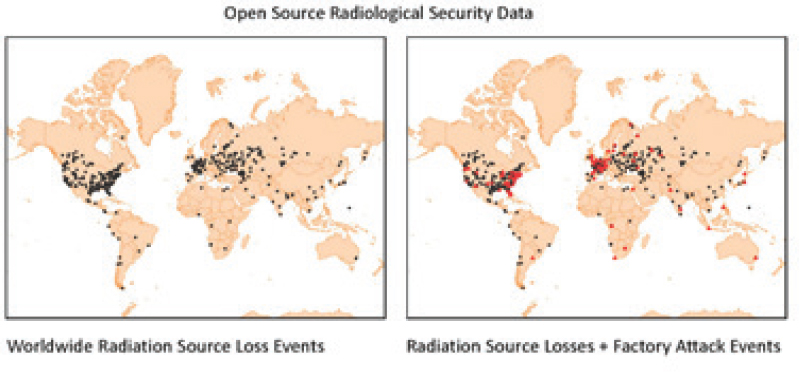
SOURCE: Presented by James Halverson, based on information from the University of Maryland (START).
Nikolay Plotnikov, Institute of Oriental Studies. The World Is Spinning into Chaos. During the summer of 2019, the Institute sent a mission to Iraq to assess the present and future of the Islamic State of Iraq and Syria, which remains centralized in directing activities from Africa to Asia by affiliates operating under a variety of organizational identities. In 2015, the Islamic State removed material of low radioactivity used in the oil fields. In 2017, a category 2 radioactive source disappeared from a U.S. company in Basra. Further, Jihadist websites give directions on how to construct dirty bombs. They clearly advocate asymmetrical methods of warfare. Use of very simple chemical weapons against the Kurds began in 2013. All the while Jihadists have considerable financial resources although their reservoir of $300 million has diminished recently. Joint efforts in countering the threats in the Middle East could be very important for both of our countries.
Kenneth Brill, U.S. Ambassador to the IAEA, retired. Strengthening International Control of Radiological Materials and Sources. The IAEA’s 2019 Incident and Trafficking Database indicates that in 2018 there were 253 incidents in 49 countries of unauthorized use or other activity involving nuclear and other radioactive material. This data call for international efforts to reduce opportunities for terrorists to acquire such material for nefarious purposes. Training, domestic legislation, activities of national regulatory bodies, management of sources, handling of orphan sources, and availability of funding have been repeatedly cited as concerns that need greater attention. To this end, a stronger security system could be created if the IAEA Code of Conduct that addresses such activities became legally binding. This could be accomplished if the Code became a Protocol of the Amended Convention on the Physical Protection of Nuclear Materials. The 2021 Review Conference of the CPPNM Convention presents an opportunity for Russia, the United States, and the European Union to lead the international community in adopting the Code as a Protocol.
Elina Kirichenko, IMEMO. Export Control of Radiologically Active Items and Technologies. Export control of radiologically active items is codified in international legally binding documents, international informal export control regimes, and national export control systems. The Non-Proliferation Treaty and the activities of the Nuclear Suppliers Group provide a basis for such export control. The United States and Russia were among the countries to adopt in 2004 U.N. Resolution 1540 that provides for monitoring the state of national mechanisms to prevent weapons of mass destruction material from falling into the hands of non-state organizations or persons. The evolution of export control schemes has led to control of intangible forms of technology transfer, inclusion of “catch-all” clauses in regulations that cover items not specified on lists, transfer of items to foreigners living in the country that controls the technology of interest, and increased attention to the end use of goods and technologies. Significant challenges to current export control systems are the emergence of break-through technologies, expansion of intangible forms of technology transfer, cybersecurity problems including control over software transfers, and brokerage in international transactions that may include schemes for illegal acquisition by intermediaries of sensitive goods and technologies.
RESPONDING TO THE THREAT OF TERRORISM
Stepan Kalmykov, Moscow State University. Monitoring Illegal Trafficking of Radioactive Materials. Nuclear Forensics is directed to the search for and identification of radioactive sources, analysis of the composition and characteristics of the sources, and determination of the origin and age of the sources. Many searches have been routinely carried out on the basis of well-established global networks to examine very small individual particles. Important search methods are based on spectroscopy, ranging from micro-spectroscopy to mass-spectroscopy. A major clue as to the age and origin of a sample is often the isotope ratios that are discovered. We have decades of experience in carrying out radio-xenon analyses of air samples resulting from nuclear weapons testing and from accidents such as the disaster at Chernobyl. At the micro-level there are a number of ways to measure the composition of particles without destroying the samples, ranging from imaging systems to sophisticated mass spectrometry. Alpha track radiography is an important tool for sampling of particles in the soil and in other matrices. (Figure 5)
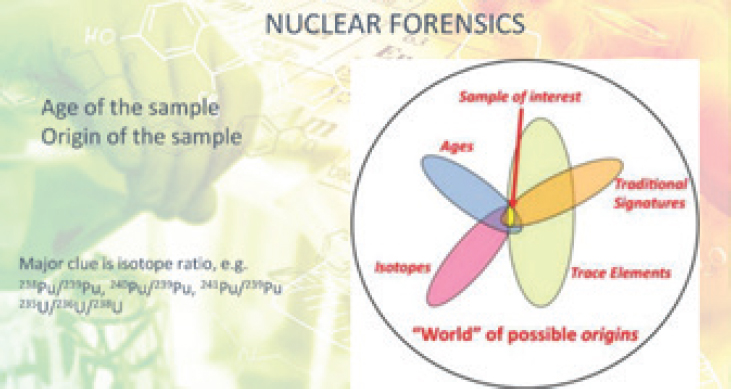
SOURCE: Figure taken from Kalmykov presentation. Presented by Stepan Kalmykov.
Michal Bijak, University of Lodz. Responding to Radiological Incidents. Guidelines for first responders are well developed for radiological incidents. General rules include: (1) consider worst-case scenarios, (2) obtain advance information that helps determine whether there is a CBRN incident, (3) maintain situational awareness, (4) ensure your personal safety, (5) do not hesitate in reporting possible threats, (6) continuously communicate your personal status, and (7) carefully select location of safe evacuation points. On the scene, be alert for presence of radiological protection equipment such as shielding containers and materials including lead or concrete, maintain continuing access to radiation measuring devices, look for presence of nuclear hazard symbols, have personal protective equipment including appropriate clothing and safety gear for seeing and breathing, and maintain access to ventilation system. Finally, with regard to victims, be alert to signs of radiation sickness including both internal (vomiting and digestive problems) and external (hair loss and burns) manifestations. (Figure 6)
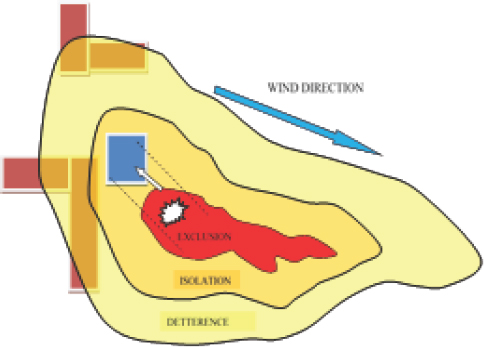
SOURCE: Presented by Michal Bijak.
Sergey Krasnoperov, Nuclear Safety Institute. Risk Analysis of Unauthorized Use of Radioactive Materials. Many factors determine the degree of hazard from use of radioactive materials in terrorism attacks. They include (1) characteristics of the isotopes that are being diverted from industrial, medical, energy, or other appropriate applications; (2) effectiveness of national and international control of radiological material, particularly with regard to applications beyond those used by the nuclear industry; (3) difficulty in creating and delivering a radioactive device on the target; (4) unanticipated damage to the health, environmental, and economic aspects of the affected region; (5) disruption of social activities; (6) level of general awareness of the scientific and legislative basis for radiation safety; and (7) communication by the government and nuclear experts with the population concerning steps to reduce radiation risks. (Figure 7)
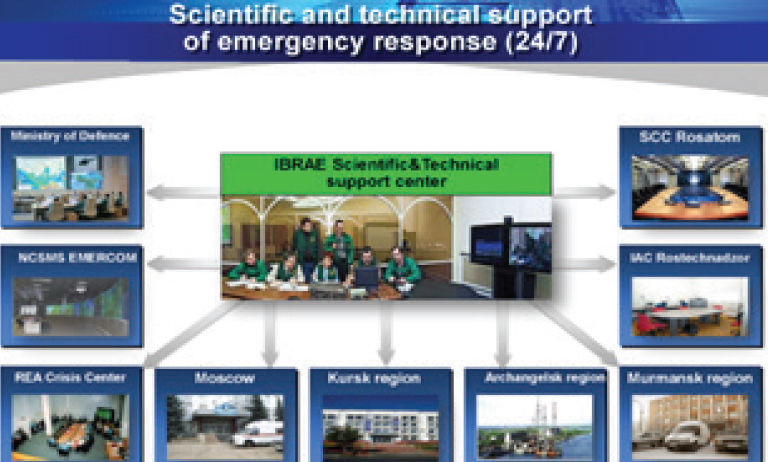
SOURCE: Presented by Sergey Krasnoperov, based on information from Institute of Nuclear Safety.
Timo Hellenberg, Hellenberg International. Threat of Terrorism Increases in Europe. Europol has reported a steady increase in the number of individuals in concluded court proceedings for terrorism activities during 2018. Verdicts for 339 incidents concerned jihadist terrorists, mostly linked to ISIS. Thirteen people were killed and more were injured in the attacks. At the same time the number of disrupted jihadist terrorist plots increased. These included attempts to produce and deploy CBRN substances although most were carried out using knives and firearms, predominantly on civilian targets. All plots relying on explosives were disrupted. As to use of CBRN materials, Europol reported plots in Paris to use black powder extract from pyrotechnics and possibly ricin, in Cologne and in Sardinia where the water supply of the Lebanese army would be poisoned. In addition two Georgians were detained in Kobuleti attempting to sell uranium. Meanwhile there has been an increase of CBRN terrorism propaganda and related threats on sport halls, shopping malls, and ferries, all of which provide suitable locations for large attacks. As in previous years, intentions to use CBRN materials were expressed mainly by jihadists. Finally an ISIS-affiliated group launched a campaign titled Bio-Terror via Telegram promoting the use of biological weapons.
Vladimir Stebelkov, Laboratory of Microparticle Analysis. Physical and Chemical Methods of Analysis for Investigation of Concealed Nuclear Activities. An international technical working group began IAEA operations in 1996. The laboratories use nine physical-chemical methods in forensic analyses to determine the presence and types of
radioactive and other materials of “nuclear significance” for ascertaining elemental and isotopic compositions of specific elements and other relevant characteristics of samples of interest. An important activity of the laboratories is to assist in developing methods and capabilities within the countries of interest that are consistent with international capabilities. The team develops recommendations, conducts inter-laboratory experiments, organizes conferences, and trains staff members. An example of an important effort in 2012 was to determine whether activity from 210Po was the cause of the death of Yassar Arafat in 2004. Three international experts could not decide from the available body samples. (Figure 8)
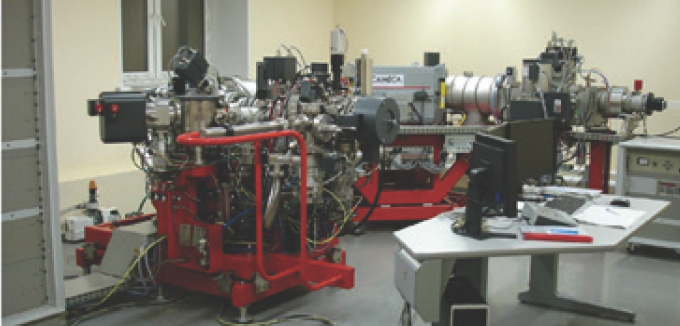
SOURCE: Presented by Vladimir Stebelkov. Photograph by IAEA.
Sergey Semenov, Kurchatov Institute. Decommissioning of Research Nuclear Reactors in Densely Populated Urban Areas. There are more than 840 research reactors worldwide, many of which are located in large cities. The operating equipment of these reactors is highly contaminated, and their decommissioning is important from a safety standpoint. It usually takes 15–20 years to decommission a reactor. Using remote diagnostic methods and robotic aids, two research nuclear reactors have been decommissioned at the Kurchatov Institute in only seven years. As a result of this work, more than 1,900 tons of solid radioactive waste and about 700 m3 of liquid radioactive waste have been removed from the Kurchatov Institute grounds; the activity of the removed radioactive waste has reached 113 TBq, and some 300 beryllium and graphite blocks have been removed from the cooling pond and reactor core. The logic of radioactive waste handling and the technologies used have been aimed at performing the work with a limited number of qualified workers with personal dose burdens not exceeding 20 percent of the individual annual doses for both external and internal exposure.
Mikhail Morev, Rostechnadzor. Regulation of Radionuclide Discharges and Emissions to the Environment. Regulatory documents adopted by Rostechnadzor call for limits on emissions and discharges which are the major sources of negative impacts of nuclear facilities on populations and the environment. The list of controlled radionuclides include those that in sum contribute 99 percent of the effective dose to critical population groups from a particular source of emissions/discharges. As to atmospheric releases the list includes 93 radionuclides, including 3H and 14C. In the case of discharges to water bodies, 80 radionuclides, including 3H, are identified. The list includes all radionuclides observable in emission/discharges of Russian- designed nuclear power plants, such as 54Mn and 90Sr. When detection equipment is not in place, specified calculation techniques approved by Rostechnadzor are applied. (Figure 9)
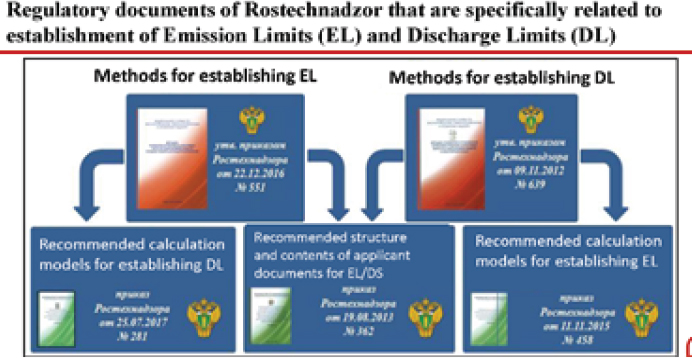
SOURCE: Presented by Mikhail Morev.
John Cochran, Sandia National Laboratories (retired). Control and Disposal of High-Activity Radioactive Sources. “Dangerous and vulnerable” 137Cs sources and similar sources are of the greatest concern to security experts, and therefore they are being removed from usage. Five options are available for these sources. Of the options, storage is not sustainable for the 1,000 + years needed for them to decay to safe levels, and to the author’s knowledge, no country has a disposal facility for these sources. To provide a permanent solution, the United States is developing a disposal facility that places the sources in concrete containers buried as deep as 36 meters. The IAEA is also assisting Member States implement a multi-barrier disposal system that places the sources in engineered stainless steel containers at depths of 30 meters with additional isolation provided by appropriate geology and geochemistry. This progress is greatly needed because moving 137Cs sources from user facilities to storage facilities does not permanently eliminate
the security threat.
Andrey Korolev, Kurchatov Institute. Handling of Spent Nuclear Fuel and Radioactive Waste in Northwestern Russia. Beginning in the 2000s, the Kurchatov Institute has participated in work to decommission nuclear facilities and eliminate the nuclear legacy under the federal targeted program, “Nuclear and Radiation Safety of Russia” and the G-8 Global Partnership. TThis includes (1) work on the environmental rehabilitation of formal coast technology bases in Andreyev Bay and Gremikha, (2) building a facility for long-term storage of reactor units from submarines and surface vessels, and (3) establishment of a regional center for conditioning and long-term storage of RW at Sayda Bay. These measures have permitted the practical realization of the principle of closing the life cycle of complex technogenic sites at nuclear facilities, ensuring the safe and environmentally clean development of nuclear technology in the Arctic.
John Miller, International Isotopes Inc. Management of Disused Radioactive Sources. Radioactive source manufacturers play a crucial role in management of sealed sources throughout their life cycles. The International Source Suppliers and Producers Association, comprised of several radioactive source manufacturers, implements a Code of Good Practices, with provisions: (1) to assist users in managing disused sources, including return to manufacturers, recycling, and access to approved storage or disposal facilities; and (2) to provide technical assistance concerning management of disused sources, including orphan sources. Take-back agreements between source users and source manufacturers have become a common business practice that is typically incorporated into the sales agreement. A take-back agreement between the source supplier and user is a proactive tool in the end of life management of disused radioactive sources. In some cases, proof of a take back agreement is a prerequisite for the source user to obtain authorization to possess the radioactive source. (Figure 10)
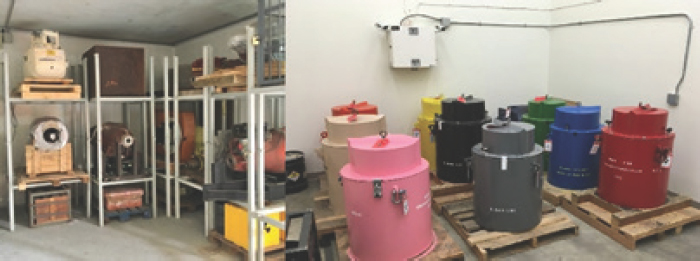
SOURCE: Presented by John Miller. Photograph provided by International Isotopes, Inc.
George Moore, Middlebury Institute of International Studies at Monterey. Alternatives to 137Cs Radiation Sources. 137Cs sources are used in food, oil and gas, medical, and construction industries as well as having commercial applications across industries. Alternatives include continued use in a physically protected form, use of x-ray or Linac, and use of other non-radioactive equivalent devices. In considering alternatives the following challenges may stand in the way: disposal of current material, upgrading for other uses of the facility where 137Cs is found, recalibration or purchase of new equipment, training of operators, and/or achievement of precise equivalence. Relatively easy changes are use of Linac in teletherapy, replacement of blood irradiators with x-ray and possibly Linac, and replacement of research irradiators with x-ray. (Figure 11)
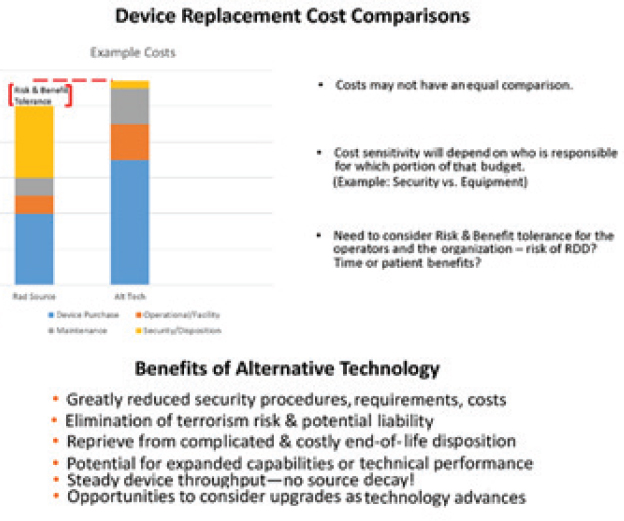
SOURCE: Presented by George Moore. Based on information from the U.S. Department of Energy.
Oleg Kiknadze, Kurchatov Institute. Handling of Sunken Nuclear- and Radiation-Hazardous Wastes in the Arctic Seas of the RF. Seven nuclear-hazardous facilities sunken or submerged in the waters of the Arctic are currently known. Submarine B-159 sank in 2003 only about 60 kilometers from Murmansk and presents the greatest hazard to the environment. Submarine K-27, which sank in 1981, contains two reactors with liquid metal coolant containing highly enriched uranium, which could lead to a chain reaction, and that is the second most serious hazard. The sunken submarines are being investigated and their effect on the environment is being studied using remotely controlled submersibles equipped with radiation detectors or underwater spectrometric systems. Long-term radio-environmental monitoring stations must be developed and created for continu-
ous monitoring of sunken objects. (Figure 12)
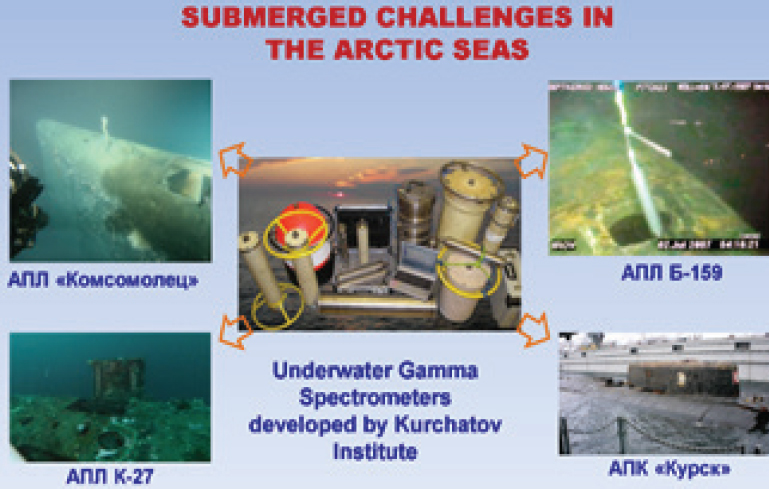
SOURCE: Presented by Oleg Kiknadze, with information from the Kurchatov Institute.
Sergey Ivanov, Medical Research Center of Radiology: Affiliate in Obninsk. Clinical Use, Storage, and Disposal Practices of Radiotherapy Procedures. (Presented by Natalya Borysheva). Radiopharmaceuticals and compounded radiochemcials are used for diagnostic and therapeutic purposes. The time needed for unused materials to decay to safe disposal levels ranges from days to several months. Sealed sources such as 60Co used for teletherapy and biological studies are often appropriate and can be stored in shielded rooms sometimes referred to as “canyons.” (Figure 13) Stereotactic radiosurgery using several 60Co sealed sources for the treatment of brain tumors and other brain anomalies have been in use for decades. 192Ir is used for high-energy contact radiation therapy at levels of Category 2 or 3. While 252 Cf could be used for contact therapy, it is now rarely used anywhere. Alternative technologies such as x-ray and LINAC are also used when appropriate.
CONTROLLING RADIOACTIVE WASTE
Vladimir Petrov, Institute of Geology of Ores, Petrography, Mineralogy, and Geochemistry. Final Stages in Disposal of Nuclear Material with Minimum Radiological Risk. A project has been designed to create a deep repository for radioactive waste in a granite base in Zheleznogorsk. This is based on a complex program of research during 2015-2016, which reduced dangers and optimized the actionable parameters in the strategic plan to be carried out by Rosatom beginning in 2019. The plan will take 50 years for implementation. It addresses many issues including the following: the expertise and personal experience required, placement of waste materials in several locations, anti-terrorism measures, use of existing technologies for mobilization of the materials, and necessary transportation measures. Also the plan must take into account the important environmental aspects of activities in the Baikal region. (Figure 14)
Elina Vanina, RADON. Safety Assessment of Storage of Radioactive Waste. The RADON facility provides long-term storage of radioactive waste, serving a highly-industrialized territory occupied by more than 20 million people. By 2030, determinations will be carried out as to whether some of the accumulated waste must be transferred to another facility for disposal or whether the waste can be safely disposed of at the existing site. Long-term preservative coatings and other approaches regularly improve the insulating properties of the storage facilities. As to community safety near the facility, assessments of dose loads affecting the nearby population during normal operations, as well as during interruptions of normal operations, are regularly carried out. To date the long-term monitoring data, inspections, and results of mathematical modeling indicate that the level of radiation at the waste storage facilities is well below acceptable levels. (Figure 15)
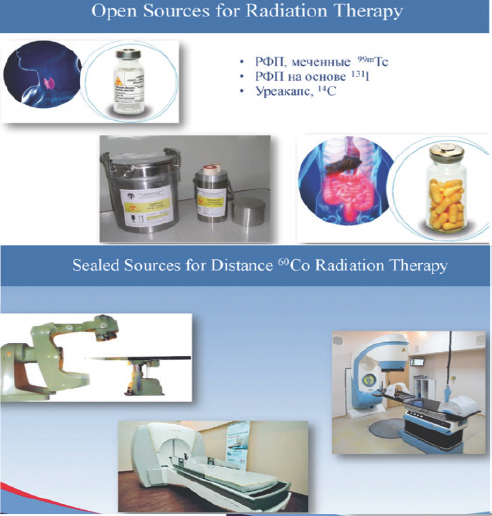
SOURCE: Presented by Natalya Borysheva. Information provided by Medical Research Center of Radiology.
Mikhail Diordiy, RADON. Disposal of Radiation Sources. During 2020, the creation of a technically modern, cost effective, and environmental friendly radioactive waste management system for disused radioactive sources of ionizing radiation treatment should be completely established. An important concern is prevention of access by terrorists to radioactive mobile sources, lost radioactive materials, and uncontrolled radioactive waste storage facilities According to Russian legisla-
tion, disused radioactive sources must be transferred to the manufacturers for reprocessing or to a specialized organization for radioactive waste storage, with subsequent transfer to the national radioactive waste management operator for final disposal. To this end, RADON has decades of experience in dealing with disused radioactive sources and radioactive waste materials at its facility. Long-term storage of disused radioactive sources in specialized storage containers allow transportation to the final disposal site when necessary. Specialized containers that do not require extraction of the disused radioactive sources minimize the possibility of losing control of the sources through loss or theft while providing opportunities for temporary storage and then final disposal of the radioactive waste. (Figure 14)
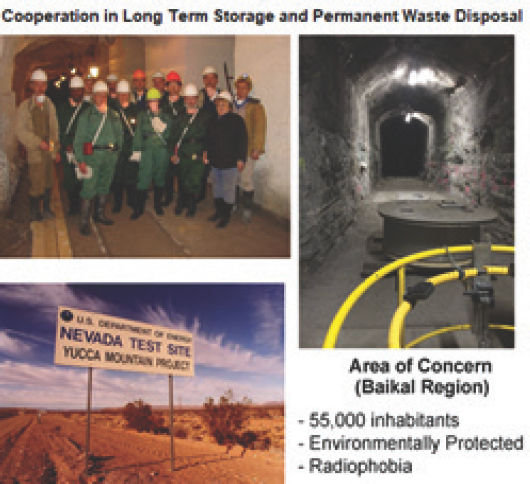
SOURCE: Presented by Vladimir Petrov.
Boris Gurovich, Kurchatov Institute. Refurbishment of VVER Reactors by Annealing. A total of 22 VVER-440 reactors and 36 VVER-1000 reactors are in service worldwide. Extending the service lives of existing reactors is a priority objective for Russia, and annealing of reactor housings is an important approach to accomplishing that. Besides the economic gain, extending service lives gives time to find more suitable sites for waste storage. In 2018, the Kurchatov Institute annealed a high-capacity reactor at Balakovo. The criteria of selection of temperature parameters for the annealing process are very important in performing this work. It is important to note that the Institute has the capability to use world-class equipment to study the impact of radiation on materials. The Institute has collaborated in this area with Oak Ridge National Laboratory, and has good prospects for expansion of international collaboration. (Figure 16)

SOURCE: Presented by Elina Vanina with information provided by RADON.
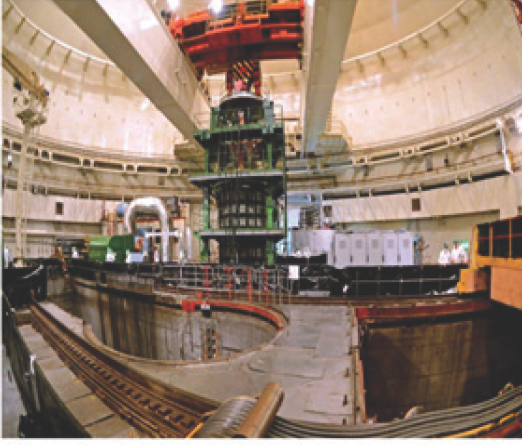
SOURCE: Presented by Boris Gurovich, with information provided by Kurchatov Institute.
OBSERVATIONS FROM BREAKOUT GROUPS AND FINAL DISCUSSION
The statements in this section are those of individual participants and do not represent any group as a whole.
Breakout Group 1: Overview of Violent Extremism and Radiological Security
- The likelihood and danger of radiological terrorism are not fully appreciated by the general public. It is difficult to increase widespread awareness or even interest in potential threats that could strike in different types of locations. Intergovernmental and governmental agencies, non-governmental scientific organizations, and individuals that are involved in the handling or protection of nuclear material have a responsibility to contribute to increasing this awareness in a balanced but forthright manner.
- The potential contribution of science diplomacy that involves cooperation in civilian-oriented nuclear activities to expanding awareness of potential misuse of nuclear research materials and equipment is not fully appreciated.
- In recent months, President Vladimir Putin has repeatedly called for international cooperation in combat-ting terrorism. This commitment underscores the importance of U.S.-Russian-European cooperation in activities, which could address use by terrorists of sophisticated weapons, including radiological devices.
- Routine U.S.-Russian-European exchanges for observing the training of emergency response teams, particularly with regard to CBRN contamination, should be considered.
- Recent reports in responsible publications and on the internet suggest that drones are being explored by terrorist groups as conveyors of CBRN materials.
- The likelihood of acquisition and misuse of radioactive material in Syria and adjacent areas has probably increased in recent months.
- While protecting well-known storage, assembly, and operational locations for radioactive material is very important, terrorists are often on the move searching for any types of weapons or material that can cause damage or deaths. Guarding against misuse of dangerous weapons should not be limited to facilities with access to only a single type of material—such as radioactive material—but should include awareness of the threats of many types of CBRN and other high-tech devices. This is particularly important in mapping the movements of well-known terrorist groups.
Breakout Group 2: Preventing Inappropriate Acquisition, Handling, and Use of Radioactive Material
- The IAEA and associated national organizations have long histories of lessons-learned in addressing activities such as improving emergency management; providing security guidance; and suggesting technological solutions to problems involving acquisition, storage, and use of radioactive materials.
- Greater recognition is needed of the importance of a widely spread and well adopted radiological security
-
culture at many levels of government and within a wide range of organizations and facilities that can take action to prevent and, when necessary, to respond to radiological incidents.
- More progress is needed in encouraging compliance with the voluntary Code of Conduct on Safety and Security of Radioactive Sources throughout governmental and non-governmental facilities, with consideration being given for the Code in time to become mandatory for signatories.
- Consideration should be given to more attention to scenarios that can result in massive social and economic effects while still not resulting in any immediate fatalities from radiation exposure. [The Code now emphasizes deterministic health effects rather than social and economic effects.]
- Expanded efforts are needed to develop and utilize alternative technologies that can replace high-activity radioactive sources currently in common usage. Eliminating whenever possible the use of 137Cs should continue to receive high priority.
- Higher priority should be given to effective disposal pathways for disused sources, including pathways back to the manufacturers. Supplementary guidance on disused sources should be high on the agenda for the IAEA meeting on the Code in June 2020.
- Greater attention should be given to insider threats at storage and other facilities, which in some instances could be a major vulnerability.
- Timely communications among relevant authorities concerning lost radioactive sources is essential in helping to ensure that law enforcement and other front-line organizations are well informed.
Breakout Group 3: Responses to Incidents Involving Radioactive Material
- The highest levels of government will often be involved in responding to radiological incidents. Designation of a trusted spokesperson, ideally with a scientific background, who works with law enforcement, health, and radiation specialists is essential.
- Immediate interest of journalists should be anticipated. There should be a single point of contact for public statements while keeping journalists up to date in incidents involving radioactive material.
- Types of radiological incidents vary widely: loss of radiological material, accident at a reactor site, irradiation of a large area, and high-intensity at a confined location, for example. This requires availability of a combination of skills and experience in responding to new and evolving situations.
- Wide-spread area monitoring is often essential to understand the level and extent of the radiological threat. Contamination of vehicles transiting the affected area may be of special concern. However, closures of large areas can have great impact in urban settings and require careful and continuous monitoring
- Gamma monitoring capability is usually very good. Since problems with alpha and beta monitoring sometimes arise, there is a need to develop hardware and software tools for coping with these challenges.
Selected Observations from the Combined Breakout Groups
- The discussion focused largely on technical aspects of prevention. However, sabotage, blackmail, and corruption aspects should also be addressed in another setting.
- While comments were focused largely on radiological challenges, governments should also address broader dimensions of violent extremism including, for example, other types of nuclear issues, cyber-crime, and biological concerns.
- Nuclear medicine and related health aspects are expanding, and the security dimensions need further attention.
- RADON is in a populated area, and the visit there should clarify the overall security process. (Figure 17)
- The interactions of Russian, U.S., and European experts were very fruitful.
Supplementary Comments by Individual Participants during Discussion Periods
- Greater attention should be given to the activities of the Arctic Council. Russian and European specialists have had extensive experience in joining in responses to radiation challenges in the Arctic and in participation in IAEA training activities in the region.
- There are often problems in integrating radiation detection techniques into different transit modalities.
- Decommissioned research reactors must be surrounded by a protection perimeter in preparation for long-term storage.
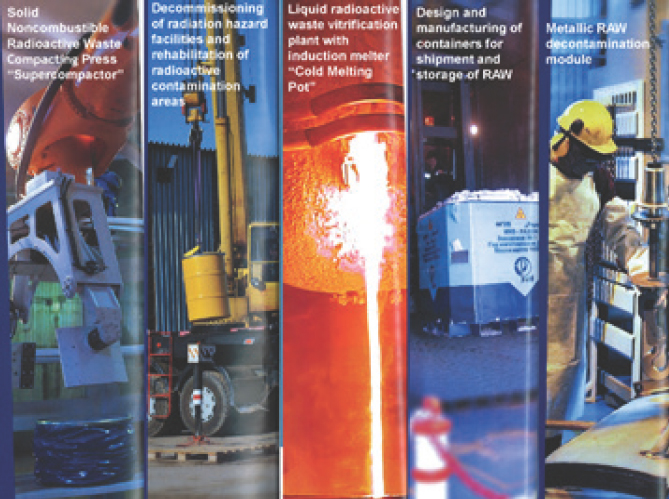
SOURCE: Presented by Elina Vanina with information provided by RADON.
- Consider invitations to foreign observers at training exercises for coping with radiological incidents.
- The IAEA has carried out mock-scene radiation management scenarios in Armenia.
- At times some nuclear scientists tend to overestimate the likelihood of serious radiation problems.
- As mentioned at an earlier workshop, Russian scientists are giving considerable attention to developing techniques for encasing 137Cs in specially prepared plastic materials. Recent progress has been reported.
- Better materials are needed for safe storage of 137Cs.
- The importance of returning disused sources to manufacturers deserves greater attention.
- The concern over the loss of sources should take into account that many category 3 sources are lost down geological holes, and sometimes they are retrieved. Nevertheless, greater attention should be given to improved inventories and records of lost sources and greater incentives to prevent such losses.
- Ensure that alerts about threats and sources are sent in a timely manner to local law enforcement and are connected with national threat awareness and intelligence assessments.
- Improve connections between local law enforcement officials to radiation safety officers at user facilities.
DISCLAIMER: This Proceedings of a Workshop—in Brief was prepared by Glenn Schweitzer and Flannery Wasson as a factual summary of what occurred at the meeting. The statements made are those of the rapporteurs or individual meeting participants and do not necessarily represent the views of all meeting participants; the planning committee; or the National Academies of Sciences, Engineering, and Medicine.
REVIEWERS: To ensure that it meets institutional standards for quality and objectivity, the Proceedings of a Workshop-in-Brief was reviewed by Gary Ackerman, State University of New York, Albany; Charles Ferguson, National Academies of Sciences, Engineering, and Medicine; Sergey Krasnoperov, Russian Academy of Sciences; George Moore, Middlebury Institute of International Studies; and Alexander Nechaev, Saint Petersburg State Institute of Technology. Marilyn Baker, National Academies of Sciences, Engineering, and Medicine, served as the review coordinator.
SPONSORS: This workshop was supported by the Battelle Memorial Institute (U.S. Department of Energy); Carnegie Corporation of New York; National Academies of Sciences, Engineering, and Medicine; Russian Academy of Sciences; Moscow State University; Institute the World Economy and International Relations; Rosatom; and RADON.
For additional information regarding the workshop, visit http: www.national.academies.org/PGA/DSC.
Suggested citation: National Academies of Sciences, Engineering, and Medicine, 2020. Scientific Aspects of Violent Extremism, Terrorism, and Radiological Security: Proceedings of a Workshop—in Brief. Washington, DC: The National Academies Press. https://doi.org/10.17226/25874.
Policy and Global Affairs
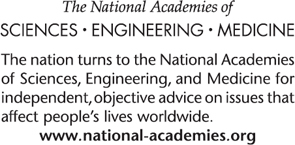
Copyright 2020 by the National Academy of Sciences. All rights reserved.














